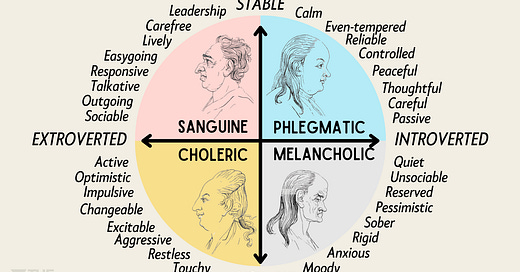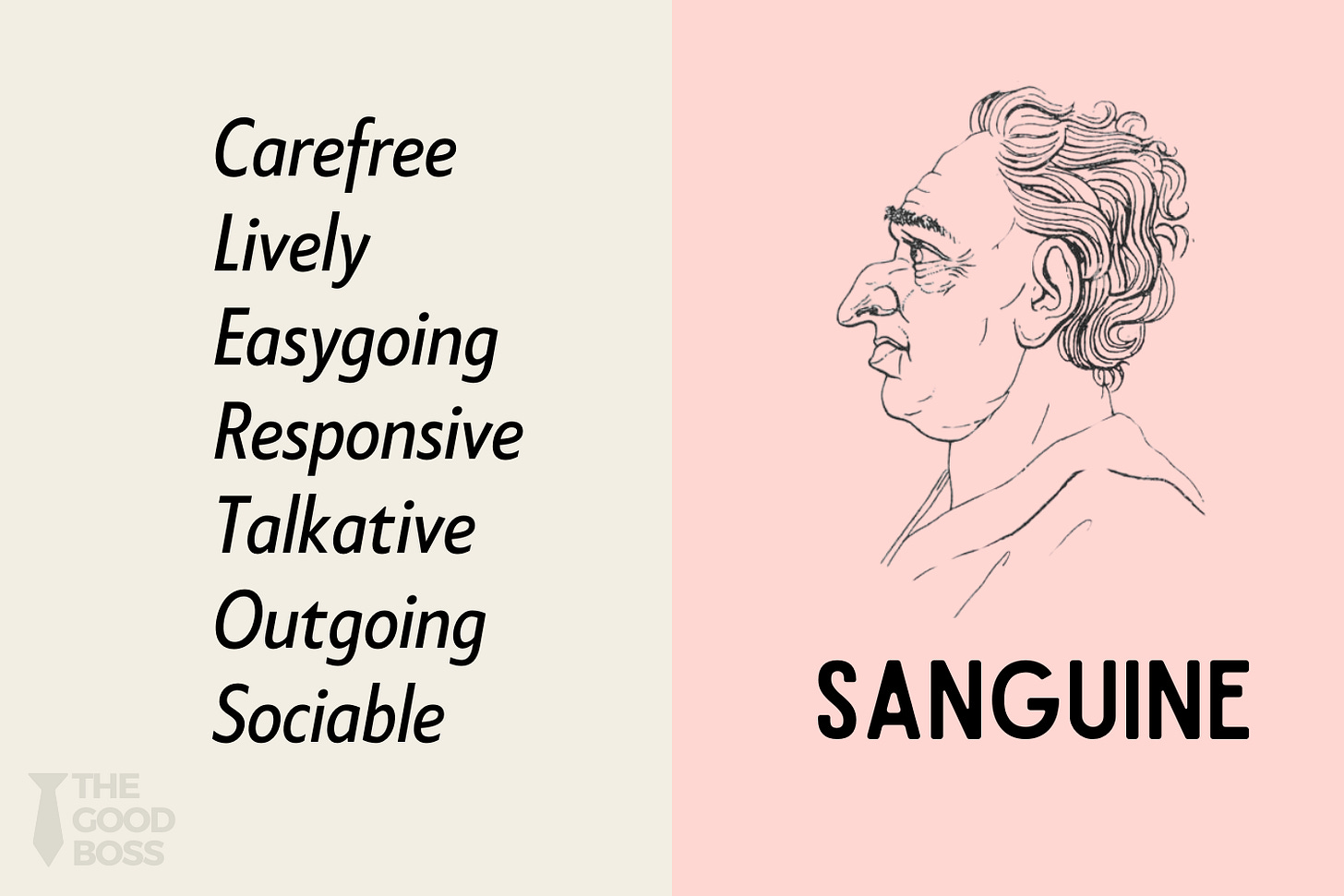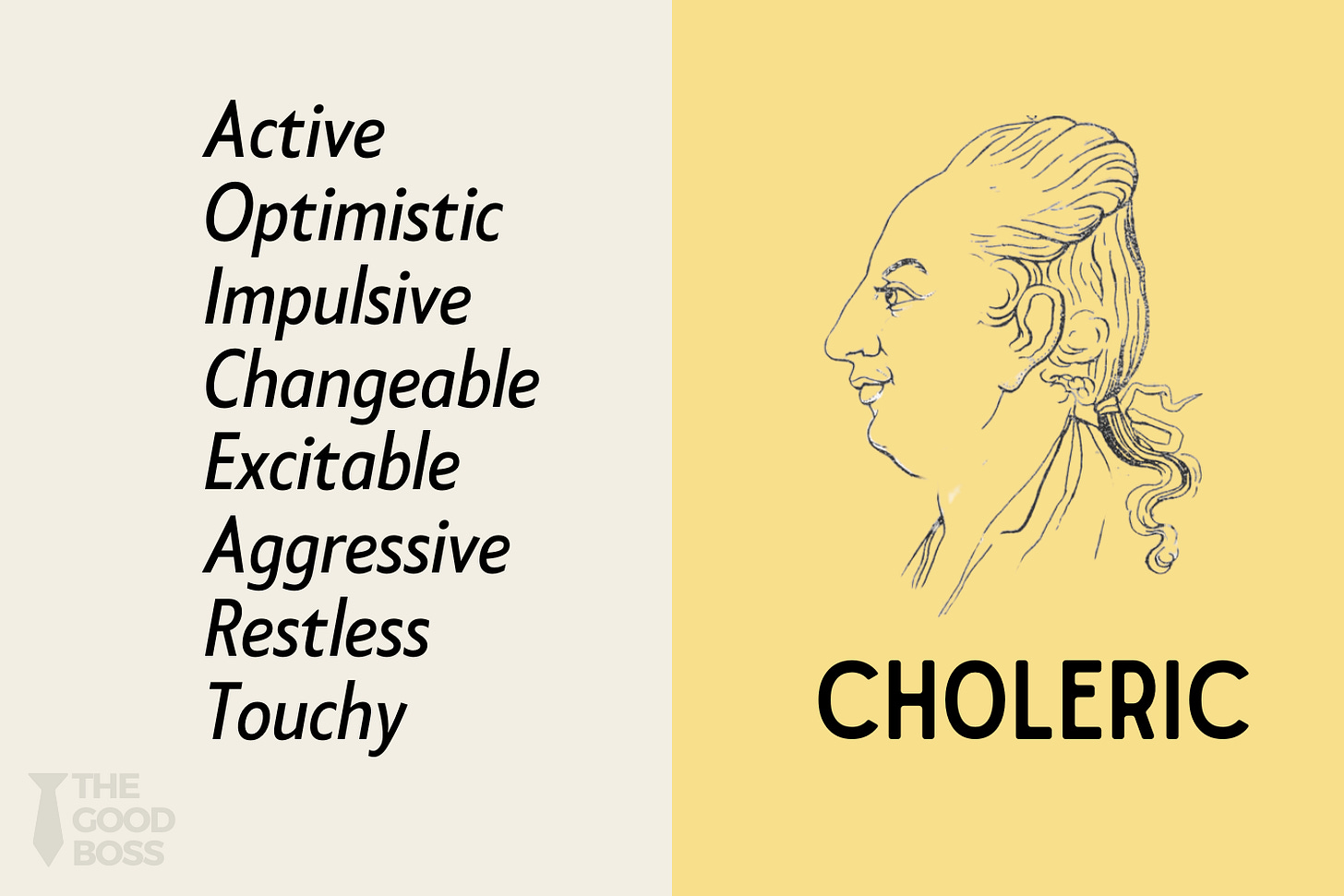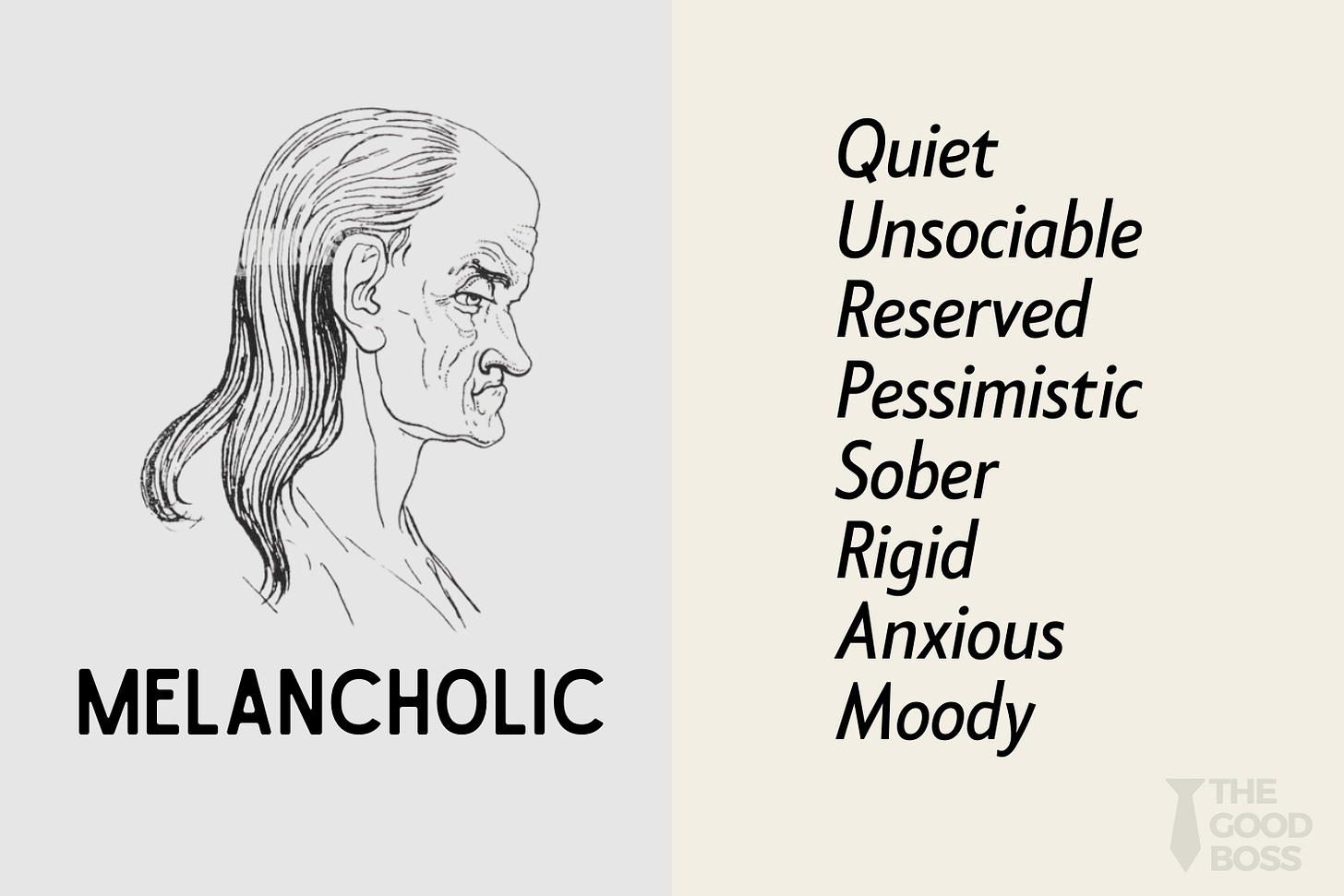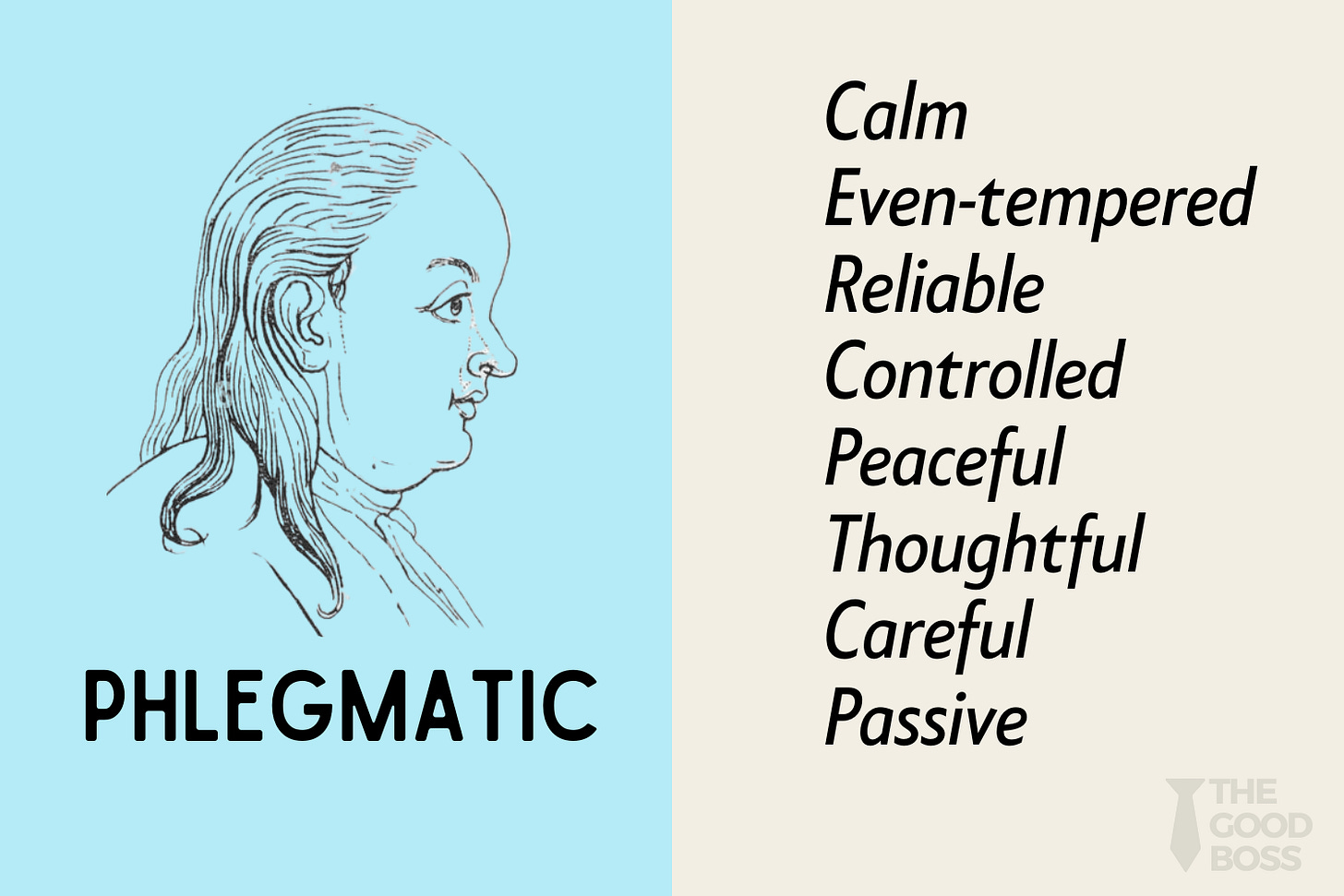The Four Temperaments: Understanding Yourself, Your Team, and Your Boss
Harness Personality Differences to Build Stronger Teams and Better Workplaces
In this issue:
Clash of the Personalities
The Sanguine Leader: The Social Butterfly
The Choleric Leader: The Determined Achiever
The Melancholic Leader: The Thoughtful Strategist
The Phlegmatic Leader: The Steady Diplomat
In Summary: The Four Temperaments
Applying The Four Temperaments in Leadership
The Four Temperaments Worksheet (free for paid subscribers)
Additional References
Final Takeaways: Leading with Awareness
✨
Clash of the Personalities
A few years ago, I was leading a team with a mix of strong personalities.
There was the extroverted, high-energy Product Manager who loved brainstorming out loud (let’s call her Sarah), and the quiet but detail-oriented developer who preferred working alone (we’ll call him Alex). In meetings, Sarah would dominate the discussion, while Alex barely spoke. Over time, I noticed Alex growing disengaged, feeling overwhelmed, while Sarah was frustrated, feeling overworked and unappreciated.
I faced a classic leadership challenge: how do you get different personalities to work together effectively?
In this post I will discuss a classic leadership framework—The Four Temperaments—a framework that helped me understand not just my own leadership style, but also my team and my boss.
Once I adjusted my approach, our team dynamic improved dramatically. The Four Temperaments can help you become:
More self-aware – knowing how your own temperament shapes your leadership style.
More people aware – understanding your team, stakeholders, and even your boss to build better relationships.
Let’s dive into each temperament and see how they show up in real life.
The Sanguine Leader: The Social Butterfly
Sanguine leaders are high-energy and expressive, thriving in social settings.
They love engaging with people—whether rallying a team, networking with stakeholders, or leading an exciting brainstorming session. Their natural charisma and optimism make them great at inspiring others.
However, their enthusiasm can sometimes lead to a lack of focus. They may jump from one idea to another and struggle with follow-through, which can be challenging when structure is needed.
Imagine a startup CEO who has a Sanguine temperament. She would likely be a magnet for investors and employees alike, energizing the company with lively town halls and creative brainstorming sessions. Who doesn’t want to be with such a personality? Yet, her enthusiasm could potentially overshadow her ability to provide a structure and process for actual deliverables, resulting in half-finished projects or constantly changing priorities.
Takeaway:
If you’re a Sanguine leader, consider pairing up with someone who is more detail-oriented. Balance your natural energy with a clear plan for execution.
The Choleric Leader: The Determined Achiever
Choleric leaders are natural-born achievers.
They are results-driven, decisive, and thrive on challenges. Their strong will and competitive spirit drive rapid progress and clear goals.
However, this intensity can make them come across as blunt or impatient. When expectations are high, team members who need more support might feel overwhelmed or undervalued.
Consider a sales director with a Choleric temperament. He pushes his team relentlessly to meet ambitious sales targets, and his direct approach often produces impressive results. Yet, this high-pressure environment results in stress and burnout for some team members. The relentless focus on results overlooked the need to support and recognize the team members.
Takeaway:
If you’re a Choleric leader, take time to listen actively and acknowledge your team’s efforts. A bit of empathy and positive reinforcement can go a long way.
The Melancholic Leader: The Thoughtful Strategist
Melancholic leaders are analytical and deeply thoughtful.
They excel in strategic planning and attention to detail, and their pursuit of excellence often results in high-quality outcomes. However, their tendency to overanalyze and seek perfection can slow down decision-making. Their need to be perfect may result in overlooking passing opportunities.
Imagine a software engineering manager with a Melancholic temperament. He holds a high bar on quality, and insists on refining every product feature before launch to ensure quality. While his high standards elevate the overall quality of the product, it also slows down releases and frustrates teams and customers who favor speed and agility.
Takeaway:
If you’re a Melancholic leader, set realistic deadlines and trust your team to deliver good work. Remember, sometimes “done” is better than “perfect.”
The Phlegmatic Leader: The Steady Diplomat
Phlegmatic leaders are the calm, stabilizing force in any team.
They excel at maintaining harmony and mediating conflicts, providing a reliable and supportive presence. Their preference for peace and harmony can create a stress-free environment, though it may unintentionally promote a suppressive culture where team members don’t feel psychologically safe to raise their concerns or call out the elephants in the room.
Imagine a project manager with a Phlegmatic temperament. She is known for keeping the team environment calm and supportive. However, when a team member underperforms, she might hesitate to address the issue directly (to avoid rocking the boat.) As you can imagine, if this continues over time, it could breed team resentment and impact deliverables.
Takeaway:
If you’re a Phlegmatic leader, work on your assertiveness. Address issues early on with kindness but firmness to prevent small problems from growing into larger conflicts.
In Summary: The Four Temperaments
The Four Temperaments framework categorizes personalities into four main types:
Sanguine (The Social Butterfly): Energetic and engaging, but sometimes lacking in focus.
Choleric (The Determined Achiever): Results-driven and decisive, yet potentially too intense for some.
Melancholic (The Thoughtful Strategist): Detail-oriented and analytical, with a risk of overthinking.
Phlegmatic (The Steady Diplomat): Calm and reliable, but may avoid necessary confrontations.
Understanding these temperaments can improve your self-awareness and sharpen your ability to manage diverse teams and stakeholders. What’s more, it can help you to know your boss at a deeper level and manage up more effectively.
Applying The Four Temperaments in Leadership
As a leader, applying the four temperaments can have a major impact on both you and your organization.
Next, we will:
Learn the three ways to apply the four temperaments in your role as a leader
Put the power of this model into practice with The Four Temperaments Application Worksheet, which includes step-by-step prompts to guide you through the application process (note: paid subscribers enjoy FREE access to the entire collection of worksheets!)
Review additional resources to further your understanding
Close out with some key takeaways

